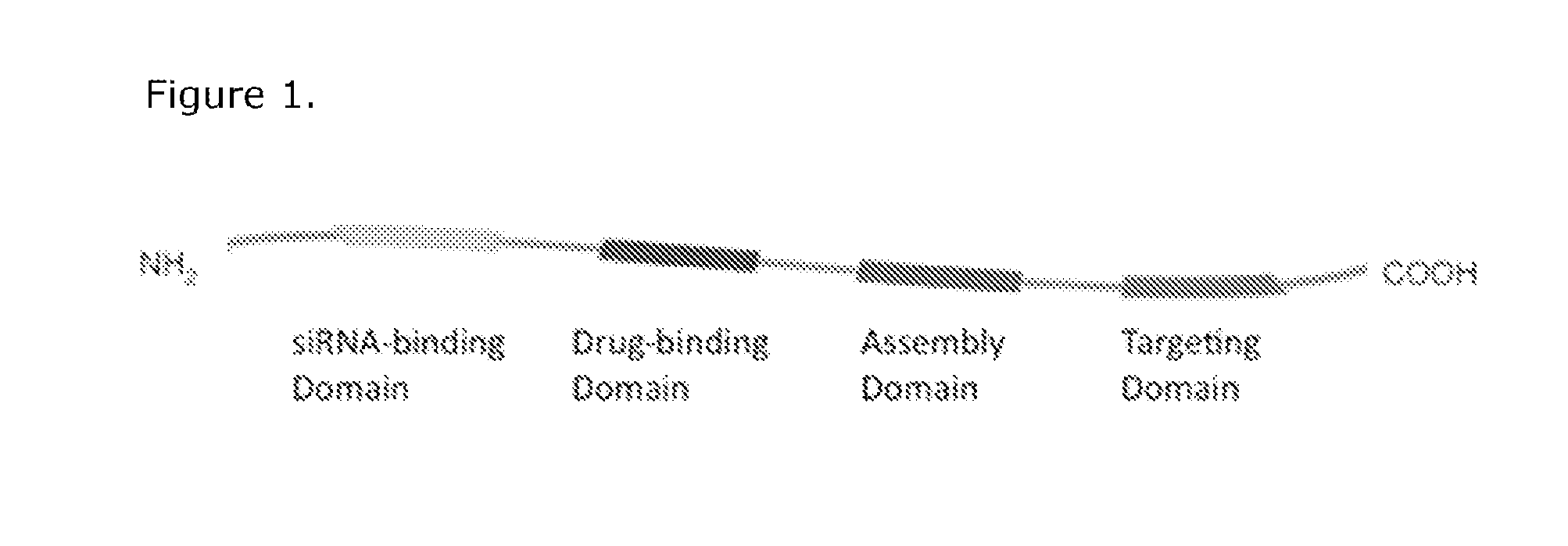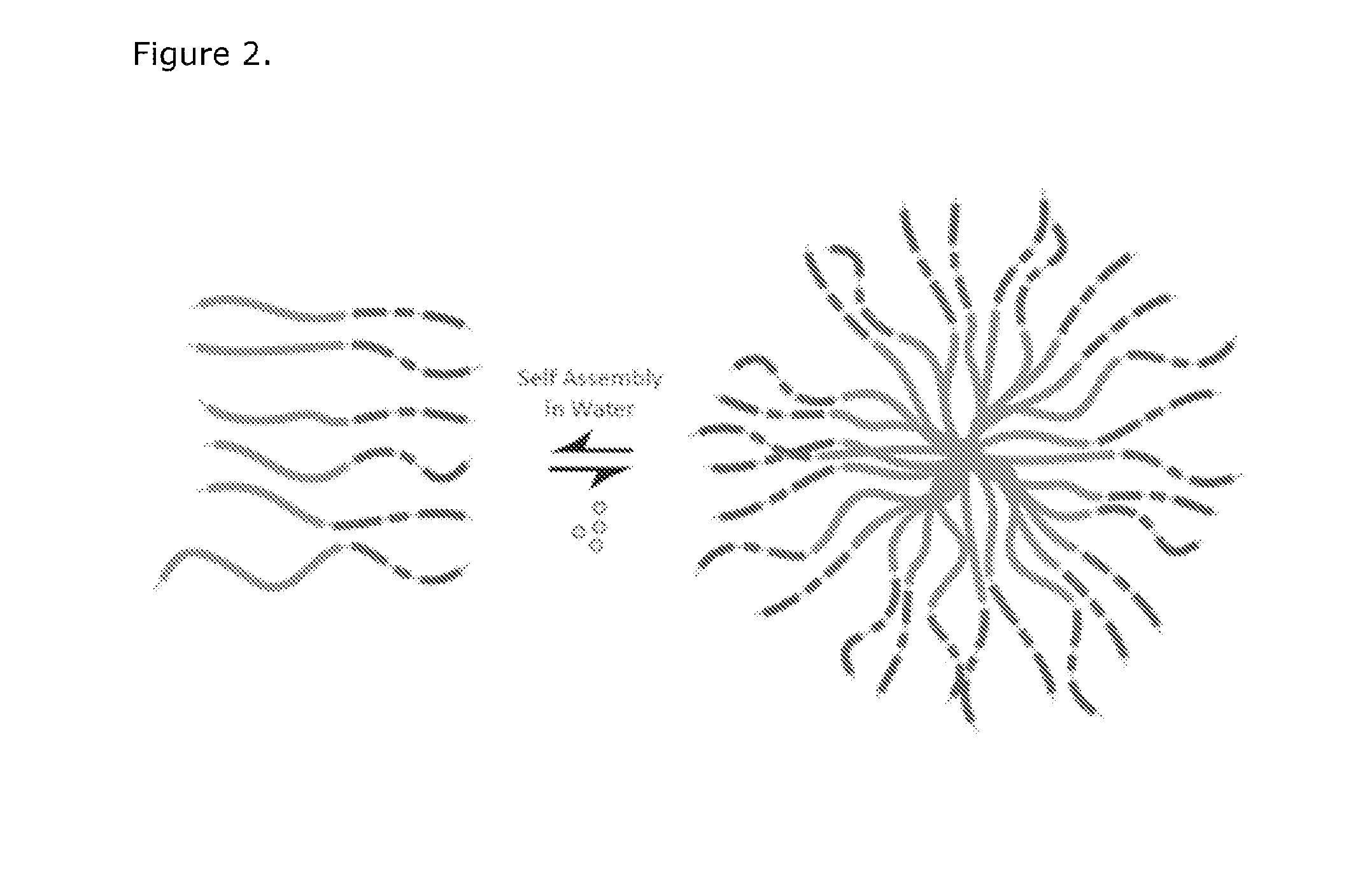Compositions of a peptide targeting system for treating cancer
a peptide targeting and cancer technology, applied in the field of molecular biology, can solve the problems of reducing the effective dose of therapeutic payload to other organs, and affecting the effect of peptides in the delivery of therapeutic molecules,
- Summary
- Abstract
- Description
- Claims
- Application Information
AI Technical Summary
Benefits of technology
Problems solved by technology
Method used
Image
Examples
example 1
Preparation and Physicochemical and In Vitro Characterization of Receptor-Targeted, ELP-Based Nanoparticles Loaded with siRNA in Cultured Human Cancer Cells
[0145]The ability of siRNA to down-regulate its target gene at the mRNA (qPCR) and protein (Western blot) level is also examined in these cell lines. The ability of ELP-containing nanoparticles to be loaded with siRNA, protect it from nuclease degradation, facilitate uptake by ovarian cancer cells via receptor-mediated endocytosis, is confirmed by the following studies.
[0146]A small library of modular, cationic tri-block biopolymers with the following architecture: (i) oligo(lysine) for siRNA condensation; (ii) elastin-like polypeptide (ELP) block—(VPGXG)n (SEQ ID No. 57) with an X substitution ratio of V5:A2:G3 for non-chromatographic purification and nanoparticle stability was genetically engineered for ovarian, breast, prostate, colon, lung and skin cancer cell targeting. This formed plasmid K8ELP(1-60) / pET25b. This recombinan...
example 2
Nanoparticle Physicochemical Condensation Assays
[0149]Electrostatic condensation of siRNA to the purified K8ELP polypeptide was confirmed by gel retardation assays and Scatchard type analysis. siRNA is labeled at the 5′ sense strand with DY547 (Dharmacon) or other suitable fluorescent label for cell-trafficking studies. The labeled siRNA was mixed at 0.2-2 N / P (molar ratio of cationic lysine amines from the biopolymer and anionic phosphate groups of the siRNA) and incubated at room temperature for 30 minutes in 1× tris base, acetic acid and EDTA (TAE), 5% glucose buffer. Biopolymer / siRNA nanoparticles were separated from free siRNA by Microcon-100 spin centrifugation. The concentrations of free and condensed siRNA were quantified by fluorometric spectrophotometry assay. The mixture was subjected to centrifugation through a Microcon-100 that retains the nanoparticle and bound siRNA, but allowed free siRNA to flow through. The concentrations of free and bound siRNA were determined usi...
example 3
Cell Targeting Domain Binding Assay
[0152]The ability of the L1CAM peptide of LK8ELP to bind tumor cells is examined via immunopreciptation assay. All other K8ELP peptides containing CTD are evaluated. Protein G MagnaBind Beads (Pierce, Rockford, Ill., Cat #21356) pre-coated with Protein G provided a ready-to-use means for purification of respective affinity targets. The high-affinity interaction between protein G and antibody does not disassociate efficiently except with very harsh conditions, such as boiling in sample loading buffer for SDS-PAGE or 8 M guanidine.HCl, pH 1.5. Magnetic beads are chosen over centrifugation or gravity methods to avoid any non-specific inclusion of nanoparticle in the precipitate.
[0153]Anti-receptor antibodies are prepared by standard polyclonal antibody production techniques in yellow goats (Bethyl Laboratories, Montgomery Tex.). Receptor-binding peptides are conjugated to keyhole limpet protein and injected repeatedly into goats. Anti-serum is isolate...
PUM
| Property | Measurement | Unit |
|---|---|---|
| temperature | aaaaa | aaaaa |
| transition temperature | aaaaa | aaaaa |
| transition temperature | aaaaa | aaaaa |
Abstract
Description
Claims
Application Information
 Login to View More
Login to View More - R&D
- Intellectual Property
- Life Sciences
- Materials
- Tech Scout
- Unparalleled Data Quality
- Higher Quality Content
- 60% Fewer Hallucinations
Browse by: Latest US Patents, China's latest patents, Technical Efficacy Thesaurus, Application Domain, Technology Topic, Popular Technical Reports.
© 2025 PatSnap. All rights reserved.Legal|Privacy policy|Modern Slavery Act Transparency Statement|Sitemap|About US| Contact US: help@patsnap.com



